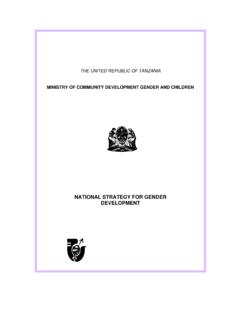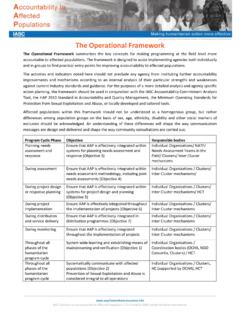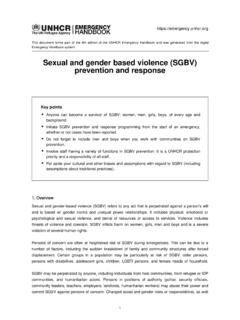Transcription of How can gender equity be addressed through health …
1 health SYSTEMS AND POLICY ANALYSIS. POLICY BRIEF 12. How can gender equity be addressed through health systems? Sarah Payne Keywords: World health Organization 2009 and World health Organization, on behalf of the European Observatory DELIVERY OF health CARE. on health Systems and Policies 2009. SEX FACTORS. health SERVICES. Address requests about publications of the WHO. ACCESSIBILITY. Regional Office for Europe to: PATIENT ADVOCACY. Publications SOCIAL JUSTICE WHO Regional Office for Europe Scherfigsvej 8. health POLICY DK-2100 Copenhagen , Denmark EUROPE Alternatively, complete an online request form for documentation, health information, or for permission to quote or translate, on the Regional Office web site ( ). All rights reserved. The Regional Office for Europe of the World health Organization welcomes requests for permission to reproduce or translate its publications, in part or in full.
2 The designations employed and the presentation of the material in this publication do not imply the expression of any opinion whatsoever on the part of the World health Organization concerning the legal status of any country, territory, city or area or of its authorities , or concerning the delimitation of its frontiers or boundaries. Dotted lines on maps represent approximate border lines for which there may not yet be full agreement. The mention of specific companies or of certain manufacturers' products does not imply that they are endorsed or recommended by the World health Organization in preference to others of a similar This policy brief is one of a nature that are not mentioned. Errors and omissions new series to meet the needs excepted, the names of proprietary products are of policy-makers and health distinguished by initial capital letters.
3 System managers. All reasonable precautions have been taken by the The aim is to develop key World health Organization to verify the information messages to support contained in this publication. However, the published evidence-informed policy- material is being distributed without warranty of any making, and the editors will kind, either express or implied. The responsibility for continue to strengthen the the interpretation and use of the material lies with the series by working with reader. In no event shall the World health authors to improve the Organization be liable for damages arising from its consideration given to policy use. The views expressed by authors, editors, or expert options and implementation. groups do not necessarily represent the decisions or the stated policy of the World health Organization.
4 How can gender equity be addressed through health systems? Contents Page Key messages Executive summary Policy brief Editors The policy issue: gender equity in health 1. WHO Regional Office for systems and health care services Europe and European Approaches for gender equity 8 Observatory on health Systems and Policies Policy approaches: three examples 13. Facilitating implementation 23 Editor Govin Permanand Summary 26. References 27 Associate Editors . Enis Bar s Josep Figueras John Lavis Author David McDaid Elias Mossialos Sarah Payne School for Policy Studies, University of Bristol, United Kingdom Managing Editors Jonathan North Kate Willows Frantzen At the request of the editorial board, this policy brief intentionally focuses on how health systems could address gender inequities in access to and quality of care, rather The authors and editors are than examining broader macro and intersectoral policies grateful to the reviewers that may be aimed at mitigating the health impact of who commented on this gender -related proximal and distal socioeconomic publication and contributed determinants.
5 As such, the stewardship role that national their expertise. ministries of health can play is raised as crucial undercurrent to the discussion, but not in relation to developing and financing policies and programmes that can close gender gaps in education and skills as called for in Closing the gap in a generation: health equity through action on the social determinants of health , the final No: 12. report of the Commission on Social Determinants of health (published by WHO in 2008). ISSN 1997-8073. How can gender equity be addressed through health systems? Key messages Policy issues Data on mortality, morbidity and use of health services reveal some important differences in health experiences between women and men. health systems can make important contributions to gender equality and gender equity by addressing gender in a variety of ways (see Box 1 on for what is meant by gender equality' and gender equity ').
6 Identifying gender inequalities and addressing gender equity are also central to good stewardship of health systems. Policy approaches/options gender equality and gender equity can be addressed by using various approaches, including legislation, organizational processes and information gathering. Regulatory approaches at national level might address patients' rights or create a duty for public-sector organizations to address gender equality. Such a duty would require health ministries to consider the ways in which health systems can reinforce inequality, and to work towards the promotion of gender equality. Organizational approaches designed to address gender equity focus on the use (in health systems) of various tools to highlight gender inequalities and pinpoint solutions. For example, gender budgeting is an organizational approach that focuses on government expenditure and makes the gender impact of budgetary decisions explicit.
7 Informational approaches focus on the role of data in providing knowledge about gender inequities. For example, gender -sensitive health indicators are intended to identify key differences between women and men in relation to health and in the social determinants of health , in order to support policy change. All approaches need to be evaluated in terms of their possible benefits, costs and the barriers that might make introducing change difficult. Benefits, for example, include increasing the visibility of gender issues, improvements in population health and in efficiency and value for money in terms of services. Costs can include the increased resources needed for training, monitoring, evaluation and the collection of any new data that might be required. Barriers may include a lack of understanding of the issues and a lack of political will.
8 Factors that might facilitate change could include gender champions' and prior Policy brief experience (at local or national level) of gender equity reforms in other policy arenas. Facilitating implementation All approaches require financial and human resources, political commitment, a long-term approach, transparent decision-making processes, gender - disaggregated data, training and the involvement of stakeholders. A strong stewardship function within the health system can help to take this forward. However, it is also the case that small changes can help to bring about further change. For example, a requirement for gender -disaggregated reporting of key health data can help generate evidence about the gender gap in health , which can, in turn, support the case for other changes. Once gender -disaggregated data have become routinely available over time, trends can be observed that help make the case for gender -related budgeting, which can begin with relatively modest goals assessing the difference between women and men in terms of the use of specific health services, for example before moving on to strategies that begin to challenge such differences or address gender equity across the system as a whole.
9 How can gender equity be addressed through health systems? Executive summary The policy issue and the nature of the problem gender differences in health and in how well health systems and health care services meet the needs of women and men are well known: in Europe, there are variations in terms of life expectancy, the risk of mortality and morbidity, health behaviours and in the use of health care services. There is also increasing research evidence demonstrating the importance of a number of different social determinants of health , and these interact with gender inequalities in ways that can magnify the impact on health . Additionally, there has also been an increasing recognition that health policy may exacerbate gender inequalities when it fails to address the needs of either men or women, and that health systems must address gender equity .
10 This forms part of good stewardship, as well as meeting the needs of the populations served. gender equity objectives have also been identified in position statements from WHO, the United Nations and the European Union (EU). For the purposes of this policy brief, the policy problem' is the way in which health systems might address gender equity in order to reduce the health gap between men and women and to improve efficiency. This document identifies some of the main approaches used to address gender equity in health systems, elaborating on three examples in order to suggest how these methods might be developed in the context of health policies across Europe. The underlying causes of the gender gap in health which might be addressed by health systems and health care services include differences between women and men in their use of preventive health care, their health behaviours and in their access to health care and treatment all of which affect health outcomes for women and men.

















